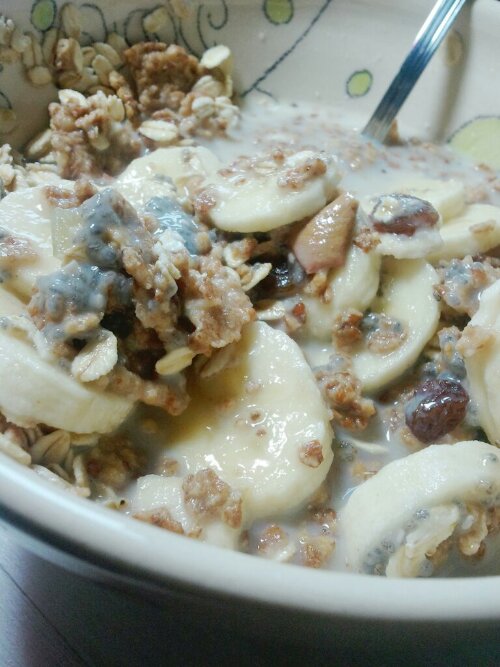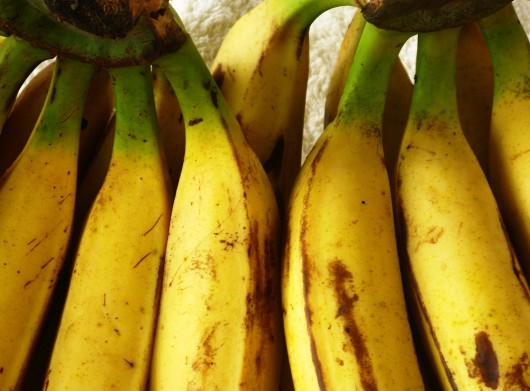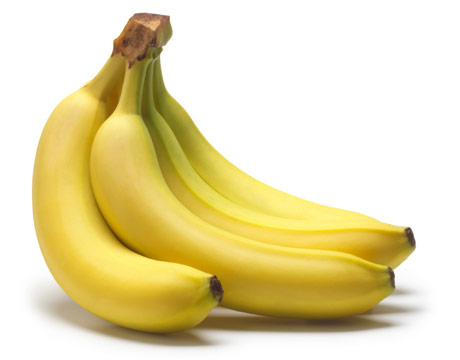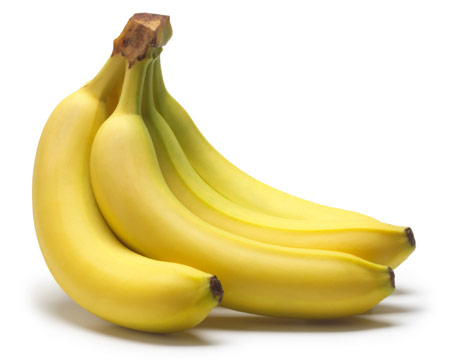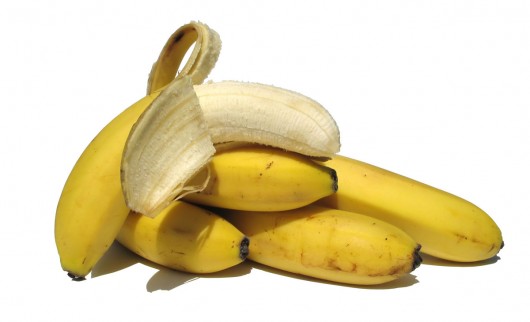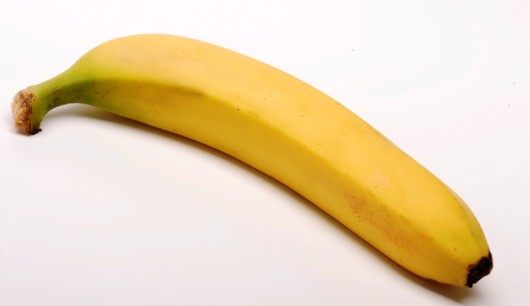Tag Archives: Banana
Best Bananas for Banana Juice and How to Choose Them
By choosing the best bananas for juicing, a smoothie made fresh in your kitchen from any combination of other additional fruits can be a refreshing and nutritious treat, especially on a warm day.
Banana Varieties
Usually harvested and shipped while green, the potassium-rich tropical fruit is one of the few in which better flavor develops when ripened off of the bush. There are hundreds of varieties of bananas, the Cavendish being the ever-popular yellow specimen on display in our supermarkets. Other bananas that have made their appearance in some United States markets include the red banana, which is shorter and sweeter than the Cavendish, and the large, firm plantain, favored for cooking in Latin American cuisine.
How To Pick A Ripe Banana
When browsing the produce aisle, look for plump bananas and consider how soon you will be using them. Peak ripeness is evidenced by yellow skin flecked with brown specks. If you do not intend to use the bananas in the next couple of days, opt for those that still bear green tints at the ends and along the edges. These still require further ripening to yield optimum flavor and texture. While ripening, keep bananas stored at room temperature, uncovered. Once ripening is complete, bananas may be stored in the refrigerator. Cool temperatures will cause the peel to turn dark brown, however the flesh will remain unchanged for several days.
Avoid any fruits with dark, soft blemishes that are indicative of bruising. Once bananas are cut and exposed to air, they will begin to brown immediately. You can retard this process by brushing the exposed banana with lemon juice.
Making Banana Juice?
Bananas actually do not yield any significant amount of juice; attempts to juice one will likely result in a blob of mush which can clog some juicers. This makes bananas ideal thickening agents for combination fruit juices or smoothies, and they provide enough sweetness that adding sugar becomes unnecessary. Juice other fruits in along with the banana and you will be rewarded with a smooth, refreshing and flavorful beverage. Pineapples, oranges, strawberries, melons, grapes, blueberries, papaya and kiwi all marry well with bananas, use any combination that your creativity conjures up. You can add a little zip by throwing a lime into the mix.
If you have an abundance of ripened bananas, you can freeze them to try another trick. Place frozen bananas into a juicer that has a blank plate or a homogenizing function. The pulp tube will present the purest, smoothest and healthiest banana ice cream that is free of added fat and sugar.
Choosing the best bananas for juicing and combining them with other fruits in your juicer is the perfect way to enjoy the luscious flavors, bright colors and healthy benefits of fruit.
Banana Juice Side Effects – Can You Drink Too Much Of It?
There are a few banana juice side effects that range from the potentially life-threatening to the mildly irritating. You should make yourself aware of these before eating the fruit or drinking its juice.
Banana Juice Side Effects And Constipation
As unripened, green bananas are particularly high in starch, there is a risk for constipation when consumed. In addition, a banana eaten before its proper time is high in pectin, which absorbs the fluid in the digestive tract and thus hardens the stool. However, as long you avoid unripened bananas, constipation is not a problem that you are likely to face.
Allergic Reactions
There are actually two possible types of allergic reactions linked to bananas – pollen allergies and latex allergies.
An allergic reaction to the pollen from banana trees may not be present at first, but can develop over time if you are already allergic to other types of tree pollen such as birch. Symptoms of an allergic reaction to tree pollen may show themselves immediately or take up to an hour after consumption to appear. The symptoms are typically isolated to the mouth and throat and may include swelling and inflammation of the lips and mouth, runny or congested nasal passages, itching, bloodshot eyes, and general fatigue.
If you are an individual with a history of allergic reactions to latex-based products you may also come to develop a reaction to bananas due to the fact that the banana is somewhat similar to natural latex. This condition is known as latex-fruit syndrome. Symptoms often vary, but can include hives, abdominal pain, swelling, inflammation, itching, and vomiting. Severe reactions can include anaphylactic shock, which includes a sudden and severe drop in blood pressure, and is potentially life-threatening.
So long as you avoid consuming unripened bananas and do not have a history of tree pollen or latex allergic reactions it is highly unlikely that you will experience any negative banana juice side effects.
5 Health Benefits of Banana Juice
Whether you’re trying to lose weight or just have a healthier diet, banana juice has many health benefits that will get you to your goal. Bananas are often called a perfect food, and there are many reasons for that. Bananas are packed with vitamins and low in fat. While the health benefits of bananas could fill a list 20 pages long, here are five major health benefits to choosing banana juice the next time you’re thirsty.
Heart Health
Bananas are both high in potassium and low in salt, which makes them a power food for people concerned about heart disease or their blood pressure. Potassium is an important part of a healthy heart, and low levels have been linked to heart disease. Since most Americans aren’t getting their recommended daily amount of potassium, it puts them at risk for heart problems. One medium banana provides about 10% of the potassium you need in a day, so drinking banana juice a few times a day can help you hit your daily goal of 4 grams of potassium a day. In fact, the USDA feels so strongly about the connection between bananas and a healthy heart that they endorse bananas as a heart healthy food.
Mood Elevation
There are a million causes of stress in your life, and it can leave you feeling sad or overwhelmed at times. Next time you feel this way, reach for a glass of banana juice. Bananas are a natural source of tryptophan, which helps the body produce serotonin. Serotonin calms you and even has a slight tranquilizing effect. Bananas also contain large amounts of vitamin B6, which regulates your mood and is an important vitamin to help your body convert tryptophan to serotonin. Since your body doesn’t make tryptophan on its own, it’s important to get it through your diet, and drinking a glass of banana juice is one of the most simple and delicious ways to do that.
Diet Assistance
The high fiber of bananas make banana juice a great choice for you if you’re trying to get more fiber in your diet, especially if you’re trying to reach a weight loss goal. One medium banana gives you 16% of the daily fiber you need. That’s around the same amount of fiber as is in a fiber supplement, without the chalky aftertaste. Fiber is an important part of a healthy diet, and helps you lose weight, since it keeps you feeling full longer. Banana juice can be an important part of your diet, whether you’re trying to get healthy or achieve a weight loss goal.
Stomach Cure-All
Another benefit of fiber is helping regulate your digestive system. Whether you’re suffering from constipation, diarrhea or just indigestion, banana juice can help get you feeling back to normal. Mothers have long known the benefits of bananas for sufferers of the stomach flu, as a part of the BRAT (bananas, rice, applesauce and toast) diet. Bananas also help to regulate stomach acid, and can help with morning sickness, indigestion and even ulcers.
A Natural Energy Drink
Banana juice is a great source of natural sugars, which provide a quick pick me up, and the fiber content means a sustained energy boost. The protein in bananas helps your heart and muscles work during exertion, and there’s no fat in a banana. That makes banana juice a perfect drink before you work out or in any situation where you need energy that comes on quick, stays for a while, and leaves you feeling great.
With all the chemicals, additives and supplements out there designed to replace a healthy diet, it’s easy to ignore the most simple solutions. A glass of banana juice is a quick, easy, healthy answer to a lot of health problems. Even if you’re just looking for a delicious drink, banana juice together with it’s health benefits is one choice you can make that doesn’t have a downside.
Which Fruit Has The Most Pyridoxine (Vitamin B6)?
Pyridoxine (Vitamin B6)
Pyridoxine is the most common of the seven forms of vitamin B6. In supplement form, the vitamin is water-soluble and can be found in many foods we eat. It is a member of the key family of vitamins, B-complex. The many benefits of these key vitamins affect crucial body systems.
The Role Of Pyridoxine (Vitamin B6) In Our Body
Together with B12, B6 creates red blood cells and other cells necessary in the immune system.
While vitamin B6 deficiency is rare, when it does occur symptoms include muscle weakness, nervousness and irritability. Severe deficiencies can result in short term memory loss and inability to concentrate on simple tasks.
B complex vitamins all work to help our bodies metabolize fat and protein. B6 is also highly involved in aiding nervous system function and contribute greatly to healthy hair, skin and eyes.
Since water-soluble vitamins aren’t stored in the body, daily intake is important to keep enough B6 in the system for good health. Of particular interest is a recent study that suggests people with heart disease do not get enough B6 in their diet. While the direct correlation is still unknown, doctors suggest making sure to get enough B6 for heart health. A large study has shown that 500mg of B6 with 1000mg of B12 taken daily significantly reduces the risk of age related macular degeneration, a condition that leads to blindness.
B6 also helps the body produce serotonin, an important key in depression prevention. Another amazing function of B6 is the ability to reduce inflammation. This ability benefits many sufferers of rheumatoid arthritis and carpel tunnel syndrome.
There can be too much of a good thing. At very high dosages of B6, side effects can include skin rash, nausea, abdominal pain, imbalance and numbness of legs and toes. The good news is that by ceasing excessive use, typically all side effects will fade within 6 months time.
Top Fruits For Pyridoxine (Vitamin B6) Content
The amounts of Pyridoxine (Vitamin B6) are given for 100g of each fruit.
1 Banana 0,37 mg
2 Jackfruit 0,33 mg
3 Durian 0,32 mg
4 Blackberry 0,30 mg
5 Carrot 0,14 mg
6 Mango 0,13 mg
7 Fig 0,11 mg
8 Pineapple 0,11 mg
9 Guava 0,11 mg
10 Kiwi 0,10 mg
11 Lychee 0,10 mg
12 Passion Fruit 0,10 mg
13 Cranberry 0,10 mg
14 Grape 0,09 mg
15 Lemon 0,08 mg
16 Tomato 0,08 mg
17 Tangerine 0,08 mg
18 Pomegranate 0,08 mg
19 Melon (Cantaloupe) 0,07 mg
20 Redcurrant 0,07 mg
21 Blackcurrant 0,07 mg
22 Pumpkin 0,06 mg
23 Orange 0,06 mg
24 Raspberry 0,06 mg
25 Apricot 0,05 mg
26 Grapefruit 0,05 mg
27 Blueberry 0,05 mg
28 Mulberry 0,05 mg
29 Cherry (sweet) 0,05 mg
30 Watermelon 0,05 mg
31 Apple 0,04 mg
32 Mangosteen 0,04 mg
33 Cucumber 0,04 mg
34 Plum 0,03 mg
35 Pear 0,03 mg
36 Peach 0,03 mg
37 Papaya 0,02 mg
Which Fruit Has The Most Selenium?
What Is Selenium?
Selenium is a trace mineral found in the earth’s crust, typically bound to other minerals to make pyrite or other compound materials. It has many interesting properties, including the ability to convert light directly to electricity, and is useful commercially for creating solar panels and photocopiers. Selenium also plays a very important, but not yet fully understood, role in human health.
Benefits Of Selenium In Our Body
In humans, selenium enters the body through foods and attaches to certain kinds of proteins. This forms an enzyme called selenoproteins. These proteins are very powerful antioxidants, attaching to free radicals and prevent them from damaging healthy cells.
Selenium is also important for the immune system. The mineral is involved in a process that helps keep white blood cell counts high, which in turn improves the body’s ability to fight off infection and disease. Selenium is also important for proper thyroid function, as it is important in creating and converting the hormones that are produced by the thyroid which helps keep metabolism humming along at a healthy clip among other important functions.
In addition, there have been some preliminary studies that selenium may help prevent certain kinds of cancers and heart disease. There is even some evidence that selenium helps with male infertility. Symptoms of selenium deficiency include hypothyroidism, fatigue, and possible reproductive issues.
Despite the wide range of benefits that selenium provides, it is important not to get too much selenium. Like many elements that bodies need only in trace amounts, selenium can become toxic at higher levels. Selenium toxicity is called selenosis, and its symptoms include fatigue, nausea and hair loss. It is almost impossible to get too much selenium through foods alone, and eating foods that contain selenium will generally provide beneficial amounts of the mineral without risking an overdose.
Top Fruits For Selenium Content
The amounts of Selenium are given for 100g of each fruit.
1 Banana 1,00 mcg
2 Apple 1,00 mcg
3 Carrot 0,90 mcg
4 Lychee 0,60 mcg
5 Papaya 0,60 mcg
6 Jackfruit 0,60 mcg
7 Redcurrant 0,60 mcg
8 Mulberry 0,60 mcg
9 Elderberry 0,60 mcg
10 Gooseberry 0,60 mcg
11 Mango 0,60 mcg
12 Guava 0,60 mcg
13 Orange 0,50 mcg
14 Pomegranate 0,50 mcg
15 Watermelon 0,40 mcg
16 Strawberry 0,40 mcg
17 Lemon 0,40 mcg
18 Melon (Cantaloupe) 0,40 mcg
19 Lime 0,40 mcg
20 Blackberry 0,40 mcg
21 Tomato 0,40 mcg
22 Pumpkin 0,30 mcg
23 Cucumber 0,30 mcg
24 Kiwi 0,20 mcg
25 Raspberry 0,20 mcg
26 Fig 0,20 mcg
27 Blueberry 0,10 mcg
28 Peach 0,10 mcg
29 Grape 0,10 mcg
30 Grapefruit 0,10 mcg
31 Pear 0,10 mcg
32 Passion Fruit 0,10 mcg
33 Tangerine 0,10 mcg
34 Cranberry 0,10 mcg
35 Apricot 0,10 mcg
Banana Nutrition Facts
Banana Nutrition Facts
Betaine 0,1 mg
Calcium 5 mg
Calories 90 Calories
Carbohydrate 22,84 g
Carotene-a 25 mcg
Carotene-ß 26 mcg
Choline 9,8 mg
Copper 0,078 mg
Dietary Fiber 2,6 g
Fluoride 2,2 mcg
Folate 20 mcg
Iron 0,26 mg
Lutein-zeaxanthin 22 mcg
Lycopene mcg
Magnesium 27 mg
Manganese 0,27 mg
Niacine 0,665 mg
Oxygen Radical Absorbance Capacity (ORAC) 795 µ mol TE
Pantothenic Acid 0,334 mg
Phosphorus 22 mg
Phytonutrients 73 mcg
Potassium 358 mg
Protein 1,09 g
Pyridoxine Vit. B6 0,367 mg
Riboflavin Vit. B2 0,073 mg
Selenium 1 mcg
Sodium 1 mg
Sugar 12 g
Thiamine 0,031 mg
Total Fat 0,33 g
Vitamin A 64 IU
Vitamin B6 0,367 mg
Vitamin C 8,7 mg
Vitamin E 0,1 mg
Vitamin K 0,5 mcg
Water 74,9 g
Zinc 0,15 mg
